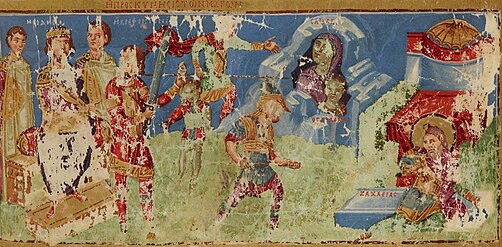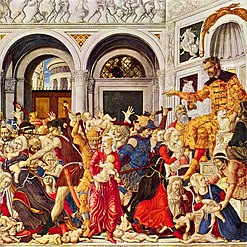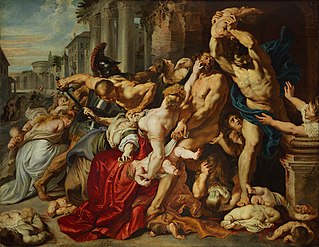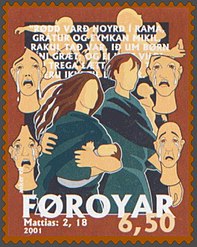Massacre of the Innocents
Holy Innocents | |
|---|---|
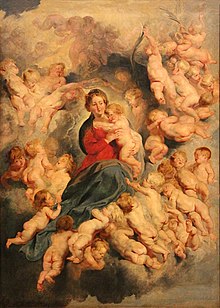 | |
| First Martyrs | |
| Born | Various, presumably close to the birth of Jesus Bethlehem, Herodian Kingdom of Judea, Roman Empire |
| Died | c. 7–2 BC Bethlehem, Herodian Kingdom of Judea, Roman Empire (martyred by King Herod the Great) |
| Cause of death | Infanticide |
| Venerated in | |
| Canonized | Pre-Congregation |
| Feast |
|
| Attributes | |
| Patronage |
|
| Events in the |
| Life of Jesus according to the canonical gospels |
|---|
 |
|
Portals: |
The Massacre (or Slaughter) of the Innocents is a story recounted in the Nativity narrative of the Gospel of Matthew (2:16–18) in which Herod the Great, king of Judea, orders the execution of all male children who are two years old and under in the vicinity of Bethlehem.[2] Modern scholarship finds no evidence that it happened outside the passages in Matthew.
The Feast of the Holy Innocents, also known as Childermas, is celebrated in the Western Christian Churches on 28 December, the fourth day of Christmastide. In Eastern Christianity, the feast is celebrated on various dates, depending on the denomination.[3]
Biblical narrative
[edit]The Gospel of Matthew tells how the Magi visit Jerusalem to seek guidance as to where the king of the Jews has been born; King Herod directs them to Bethlehem and asks them to return to him and report, but they are warned in a dream that Herod wishes to find the child and kill him, and do not do so. Matthew continues:
When Herod realized that he had been outwitted by the Magi, he was furious, and he gave orders to kill all the boys in Bethlehem and its vicinity who were two years old and under, in accordance with the time he had learned from the Magi.
— Matthew 2:16[4]
This is followed by a reference to and quotation from the Book of Jeremiah (Jeremiah 31:15) (Jeremiah 31:14 in the Hebrew Bible): "Then what was said through the prophet Jeremiah was fulfilled: A voice is heard in Ramah, weeping and great mourning, Rachel weeping for her children and refusing to be comforted, because they are no more." (Matthew 2:17–18). The relevance of this to the massacre is not immediately apparent, as Jeremiah's next verses go on to speak of hope and restoration.[5]
History and theology
[edit]The historicity of the Matthew account is not accepted by many scholars.[6][2][7] The story of the massacre is found in no gospel other than Matthew, nor is it mentioned in the surviving works of Nicolaus of Damascus (who was a personal friend of Herod the Great), nor in Josephus's Antiquities of the Jews, despite his recording many of Herod's misdeeds, including the murder of three of his own sons.[8] The early 5th-century account of Macrobius—that "on hearing that the son of Herod, king of the Jews, had been slain when Herod ordered that all boys in Syria under the age of two be killed, [Augustus] said, 'It's better to be Herod's pig than his son'"—has been discounted as extra-biblical evidence for the event due to its later authorship, possible influence by the gospel narrative, and the confused nature of the account.[9] In view of the lack of independent confirmation that the event occurred, many scholars hold that the story is folklore inspired by Herod's reputation.[7]
Historian Paul L. Maier contended that the story's invention would have been a liability for Christians and—by pointing to Herod's violent actions and plans—argued that "one of the most doubted episodes in the New Testament has stronger historical credibility than it has thus far been accorded in critical scholarship."[10] New Testament scholar Richard T. France held that, if this were a historical incident, it is unsurprising that it was not recorded by other historical sources due to the likely limited scale of the violence. While France believed that Josephus would have mentioned the event had he been aware of it, France would not have been surprised if Josephus was ignorant of what would have been a minor episode of local violence.[11] New Testament scholar Eugene Eung-Chun Park contested France's conclusion, saying that a small-scale massacre would have still "merited a remark by competent historians".[12]
Joan E. Taylor and Anthony Le Donne observe that Herod was a vindictive and harsh ruler, while it was common for Jews at the time to face becoming refugees, frequently in Egypt. [13] Taylor argues that the Historical Jesus could indeed have been a refugee whose background shaped his teachings. [14] James DG Dunn also views Herod's massacre as an action in line with his known character. [15]
The author appears to have modeled the episode on the biblical story of Pharaoh's attempt to kill the Israelite children in the Book of Exodus, as told in an expanded version that was current in the 1st century.[16] In that expanded story, Pharaoh kills the Hebrew children after his scribes warn him of the impending birth of the threat to his crown (i.e., Moses), but Moses' father and mother are warned in a dream that the child's life is in danger and act to save him.[17] Later in life, after Moses has to flee, like Jesus, he returns when those who sought his death are themselves dead.[17]
As a matter of understanding what the myth is trying to communicate, its lack of historicity is unsurprising given that gospels were primarily written as theological documents rather than chronological timelines.[18][19][20][21]
Numbers
[edit]The Byzantine Rite liturgy asserts 14,000 Holy Innocents, while an early Syrian list of saints asserts 64,000. Coptic sources assert 144,000 and that it took place on 29 December.[22] Frederick George Holweck's 1910 entry on the subject in the Catholic Encyclopedia referenced estimates that both assumed the event actually occurred and recognized that Bethlehem was too small a town to provide such numbers, reducing the victims to between six and 20 children in the town.[a] France, citing estimates that Bethlehem's population would have been around 1,000 people at the time the event was supposed to occur, concurred with an upper limit of around 20 children killed if it was indeed a historical event.[11]
In Christian art
[edit]Medieval liturgical drama recounted Biblical events, including Herod's slaughter of the innocents. The Pageant of the Shearmen and Tailors, performed in Coventry, England, included a haunting song about the episode now known as the Coventry Carol. The Ordo Rachelis tradition of four plays includes the Flight into Egypt, Herod's succession by Archelaus, the return from Egypt, as well as the Massacre, all centered on Rachel weeping in fulfillment of Jeremiah's prophecy. These events were likewise in one of the medieval N-Town Plays.[citation needed]
The "Coventry Carol" is a Christmas carol dating from the 16th century. The carol was performed in Coventry in England as part of a mystery play called The Pageant of the Shearmen and Tailors. The play depicts the Christmas story from chapter two in the Gospel of Matthew. The carol refers to the Massacre of the Innocents, in which Herod ordered all male infants two years old and under in Bethlehem to be killed.[23] The lyrics of this haunting carol represent a mother's lament for her doomed child. The author is unknown. The oldest known text was written down by Robert Croo in 1534, and the melody dates from 1591.[24] The carol is traditionally sung a cappella.[citation needed]
The 17th century Dutch Christmas song O Kerstnacht, schoner dan de dagen, while beginning with a reference to Christmas Night, is about the Massacre of the Innocents. In 1974, the Dutch progressive rock band Focus recorded the first two verses of the song for their album Hamburger Concerto.[citation needed]
The theme of the "Massacre of the Innocents" has provided artists of many nationalities with opportunities to compose complicated depictions of massed bodies in violent action. It was an alternative to the Flight into Egypt in cycles of the Life of the Virgin. It decreased in popularity in Gothic art, but revived in the larger works of the Renaissance, when artists took inspiration for their "Massacres" from Roman reliefs of the battle of the Lapiths and Centaurs to the extent that they showed the figures heroically nude.[25] The horrific subject matter of the Massacre of the Innocents also provided a comparison of ancient brutalities with the brutalities of the early modern period, during the period of religious wars that followed the Reformation – Bruegel's versions show the soldiers carrying banners with the Habsburg double-headed eagle.[26]
The 1590 version by Cornelis van Haarlem also seems to reflect the violence of the Dutch Revolt. Guido Reni's early (1611) Massacre of the Innocents, in an unusual vertical format, is at Bologna.[27] The Flemish painter Peter Paul Rubens painted the theme more than once. One version, now in Munich, was engraved and reproduced as a painting as far away as colonial Peru.[28]
Paintings
[edit]- Massacre of the Innocents by the Bruegels. Several versions of The Massacre of the Innocents were painted by Pieter Bruegel the Elder (c. 1565–67) and his son Pieter Brueghel the Younger (into the 17th century).
- Massacre of the Innocents by Guido Reni, created in 1611 for the Basilica of San Domenico in Bologna, but now in the Pinacoteca Nazionale in that city
- Two versions by Peter Paul Rubens, painted in 1611–1612 and 1636–1638
- The Massacre of the Innocents by Nicolas Poussin, painted between 1625 and 1632
- Massacre of the Innocents by Matteo di Giovanni[non-primary source needed]
Music
[edit]The communion motet for the Feast of the Holy Innocents is the text from Matthew 2:18 (citing Jeremiah 31:15) Vox in Rama. This was set polyphonically by a number of composers of the renaissance and baroque, including Jacob Clemens non Papa, Giaches de Wert, and Heinrich Schütz (in German).
Marc-Antoine Charpentier composed an oratorio, Caedes sanctorum innocentium, H.411, for soloists, chorus, two violins, and continuo (1683–1685).
Feast day
[edit]Dates by denomination
[edit]Today, the date of Holy Innocents' Day, also called the Feast of the Holy Innocents, or Childermas or Children's Mass,[clarification needed] varies.
- 27 December for West Syrians (Syriac Orthodox Church, Syro-Malankara Catholic Church, and Maronite Church)
- 28 December in the Church of England (Festival),[29] the Lutheran Church, and the Roman Rite of the Catholic Church, with these Western Christian denominations celebrating Childermas as the fourth day of Christmastide[30]
- 29 December for the Eastern Orthodox Church[31]
Beginnings
[edit]The commemoration of the massacre of the Holy Innocents, traditionally regarded as the first Christian martyrs, if unknowingly so,[32][b] first appears as a feast of the Western church in the Leonine Sacramentary, dating from about 485. The earliest commemorations[clarification needed] were connected with the Feast of the Epiphany, 6 January: Prudentius mentions the Innocents in his hymn on the Epiphany. Leo in his homilies on the Epiphany speaks of the Innocents. Fulgentius of Ruspe (6th century) gives a homily De Epiphania, deque Innocentum nece et muneribus magorum ("On Epiphany, and on the murder of the Innocents and the gifts of the Magi").[c]
Catholic medieval traditions
[edit]From the time of Charlemagne, Sicarius of Bethlehem was venerated at Brantôme, Dordogne as one of the purported victims of the Massacre.[33]
In the Middle Ages, especially north of the Alps, the day was a festival of inversion involving role reversal between children and adults such as teachers and priests, with boy bishops presiding over some church services.[34] Bonnie Blackburn and Leofranc Holford-Strevens suggest that this was a Christianized version of the Roman annual feast of the Saturnalia (when even slaves played "masters" for a day). In some regions, such as medieval England and France, it was said to be an unlucky day when no new project should be started.[35]
There was a medieval custom of refraining where possible from work on the day of the week on which the feast of "Innocents Day" had fallen for the whole of the following year until the next Innocents Day. Philippe de Commynes, the minister of King Louis XI of France, tells in his memoirs how the king observed this custom, and describes the trepidation he felt when he had to inform the king of an emergency on the day.[36]
Contemporary traditions in Western Christianity
[edit]In denominations of Western Christianity, such as Catholicism and Lutheranism, some Christians attend Mass on Childermas to remember the martyrdom of the Holy Innocents.[3][37]
In England, the memorial is referred to as Childermas or Children's Mass in which "Children are given a blessing; they sing in the choir and take on other special roles in the church service."[38]
In Spain, Hispanic America, and the Philippines,[39] 28 December is still a day for pranks, equivalent to April Fool's Day in many countries. Pranks (bromas) are also known as inocentadas and their victims are called inocentes; alternatively, the pranksters are the inocentes and the victims should not be angry at them, since they could not have committed any sin. One of the more famous of these traditions is the annual "Els Enfarinats" festival of Ibi in Alacant, where the inocentes dress up in full military dress and incite a flour fight.[40]
In Trinidad and Tobago, Catholic children have their toys blessed at a Mass.[41]
Roman Rite before and after 1955
[edit]In the Roman Rite prior to 1955, a unique feature of this feast was the use of liturgical elements ordinarily ascribed to penitential days—including violet vestments, the omission of the Gloria, and the substitution of a Tract in place of the Alleluia—unless the feast fell on Sunday, in which case the rubrics required the feast to be celebrated as on its octave day, with red vestments, Gloria, and Alleluia. The octave of this feast was suppressed by Pope Pius XII in 1955, with the feast now celebrated using the features formerly ascribed to its octave day, a practice reinforced by the 1960 Code of Rubrics.
Gallery
[edit]-
Herod orders the Massacre of the Innocents; the Flight of Elizabeth; the martyrdom of Zachariah (illumination from a 9th-century manuscript)
-
10th-century illuminated manuscript
-
Giotto, Massacre of the Innocents
-
Panel from Dreikönigsaltar by Hans Pleydenwurff 1460-1465
-
The Massacre of the Innocents at Bethlehem, by Matteo di Giovanni
-
Cornelis van Haarlem, Massacre of the Innocents, 1590, Rijksmuseum
-
Rubens, Massacre of the Innocents, 1610–11, Toronto
-
Jacopo Tintoretto, Massacre of the Innocents
-
François-Joseph Navez, The massacre of the innocents, 1824
-
Triumph of the Innocents by William Holman Hunt
-
The scream from Ramah, 2001 stamp of the Faroe Islands
See also
[edit]- Chapel of the Milk Grotto
- Church of the Nativity § Tombs
- Coventry Carol
- Flight into Egypt
- Jesus and Messianic prophecy § Jeremiah 31:15
- Star of Bethlehem
Notes
[edit]- ^ Holweck 1910 states "The Greek Liturgy asserts that Herod killed 14,000 boys (ton hagion id chiliadon Nepion), the Syrians speak of 64,000, many medieval authors of 144,000, according to Apocalypse 14:3. Writers who accept the historicity of the episode reduce the number considerably, since Bethlehem was a rather small town. Joseph Knabenbauer brings it down to fifteen or twenty (Evang. S. Matt., I, 104), August Bisping to ten or twelve (Evang. S. Matt.), Lorenz Kellner to about six (Christus und seine Apostel, Freiburg, 1908)".
- ^ Irenaeus (Adv. Haer. iii.16.4) and Cyprian (Epistle 56)
- ^ Prudentius, Leo, and Fulgentius are noted in Smith & Cheetham 1875, pp. 839ff.
References
[edit]Citations
[edit]- ^ "Patron Saints A-Z". catholic.org.
- ^ a b Litwa, M. David (2019). "Chapter 8: Child in Danger, Child of Wonder". How the Gospels Became History – Jesus and Mediterranean Myths. Yale University Press. pp. 118–120. ISBN 9780300249484.
- ^ a b Crump, William D. (2022). The Christmas Encyclopedia (4th ed.). McFarland. p. 263. ISBN 978-1-4766-8790-2.
- ^ Matthew 2:16
- ^ Clarke 2003, p. 23.
- ^ George, Arthur (2020). The Mythology of America's Seasonal Holidays: The Dance of the Horae. Springer International Publishing. p. 218. ISBN 978-3-030-46916-0. Retrieved 24 June 2024.
- ^ a b Magness 2021, p. 126.
- ^ Clarke 2003, p. 22.
- ^ Maier 1998, p. 187.
- ^ Maier 1998, p. 189.
- ^ a b France, Richard T. (1979). "Herod and the Children of Bethlehem". Novum Testamentum. 21 (2): 114–119. doi:10.2307/1560717. JSTOR 1560717.
- ^ Park 2013, p. 473.
- ^ Le Donne, Anthony (2018). Jesus: A Beginner's Guide. Oneworld Publications. p. 246. ISBN 978-1786071446.
- ^ Taylor, Joan (7 September 2015). "Jesus was a Refugee". The Jesus Blog. Retrieved 10 October 2024.
- ^ Dunn, James (2017). Who Was Jesus? (Little Books of Guidance). Church Publishing. p. 9. ISBN 978-0898692488.
- ^ Lincoln 2013, p. 44.
- ^ a b Brown 1978, p. 11.
- ^ Interpreting Gospel Narratives: Scenes, People, and Theology by Timothy Wiarda 2010 ISBN 0-8054-4843-8 pp. 75–78
- ^ Jesus, the Christ: Contemporary Perspectives by Brennan R. Hill 2004 ISBN 1-58595-303-2 p. 89
- ^ The Gospel of Luke by Timothy Johnson 1992 ISBN 0-8146-5805-9 p. 72
- ^ Recovering Jesus: the witness of the New Testament Thomas R. Yoder Neufeld 2007 ISBN 1-58743-202-1 p. 111
- ^ Mina 1907, pp. 300-.
- ^ "The Coventry Carol".
The version from Bramley and Stainer (1878)
- ^ Studwell 1995, p. 15.
- ^ "Getty Collection". Getty.edu. 7 May 2009. Archived from the original on 5 December 2005. Retrieved 15 June 2012.
- ^ A winter landscape with the Massacre of the Innocents, Sotheby's, 7 December 2005
- ^ "Reni's painting at the Web Gallery of Art". Wga.hu. Retrieved 15 June 2012.
- ^ The Massacre of the Innocents in Cuzco Cathedral is clearly influenced by Rubens. See CODART Courant, December 2003, 12. (2.5 MB pdf download)
- ^ "The Calendar". The Church of England. Retrieved 10 April 2021.
- ^ "Day Four: December 28, Feast of the Holy Innocents". Catholic Culture. Retrieved 27 December 2015.
- ^ troparia, All; saints, kontakia · All lives of. "Lives of the Saints". www.oca.org.
- ^ Smith & Cheetham 1875, pp. 839–.
- ^ Wasyliw 2008, p. 46.
- ^ Holweck 1910.
- ^ Blackburn & Holford-Strevens 1999, pp. 537–538.
- ^ de Commynes 1972, pp. 253–254.
- ^ "Feast of the Holy Innocents". Madison, Wisconsin: Lutheran Campus Ministry. 28 December 2020. Retrieved 29 December 2023.
- ^ Pennoyer, Greg; Bevis, Beth (1 September 2015). God With Us: God With Us: Rediscovering the Meaning of Christmas (Reader's ed.). Paraclete Press. ISBN 978-1-61261-819-7.
- ^ Erichsen, Gerald (11 May 2019). "Equivalent of April Fools' Day Celebrated in December". ThoughtCo. Retrieved 30 March 2021.
- ^ BBC News report of the 2010 festival.
- ^ "'Feast of Holy Innocents', Trinity and Tobago Newsday". Newsday.co.tt. 30 December 2013. Retrieved 16 April 2018.[dead link]
Sources
[edit]- Blackburn, Bonnie J.; Holford-Strevens, Leofranc (1999). The Oxford Companion to the Year. Oxford University Press. ISBN 978-0-19-214231-3.
- Brown, Raymond Edward (1978). An Adult Christ at Christmas: Essays on the Three Biblical Christmas Stories. Liturgical Press. ISBN 978-0-8146-0997-2.
- Clarke, Howard (2003). The Gospel of Matthew and Its Readers: A Historical Introduction to the First Gospel. Indiana University Press. ISBN 0-253-11061-0.
- de Commynes, Philippe (1972). Memoirs: The Reign of Louis XI, 1461-83. Penguin Books. ISBN 978-0-14-044264-9.
- Ferguson, Everett (2003). Backgrounds of Early Christianity. Wm. B. Eerdmans Publishing. ISBN 978-0-8028-2221-5.
- France, R. T. (2007). The Gospel of Matthew. Eerdmans. ISBN 978-0-8028-2501-8.
- Grant, Michael (1971). Herod the Great. American Heritage Press. ISBN 978-0-07-024073-5.
- Harrington, Daniel (1991). The Gospel of Matthew. Liturgical Press. ISBN 978-0-8146-5803-1.
- Holweck, Frederick George (1910). . In Herbermann, Charles (ed.). Catholic Encyclopedia. Vol. 7. New York: Robert Appleton Company.
- James (2019). The Protoevangelium of James: Greek and English Texts. Translated by Walker, Alexander. Dalcassian. ISBN 978-1960069023.
- Lincoln, Andrew (2013). Born of a Virgin?: Reconceiving Jesus in the Bible, Tradition, and Theology. Eerdmans. ISBN 978-0-8028-6925-8.
- Magness, Jodi (2021). Masada: From Jewish Revolt to Modern Myth. Princeton University Press. p. 126. ISBN 978-0-691-21677-5.
- Maier, Paul L. (1998). "Herod and the Infants of Bethlehem". In Summers, Ray; Vardaman, Jerry (eds.). Chronos, Kairos, Christos II: Chronological, Nativity, and Religious Studies in Memory of Ray Summers. Mercer University Press. ISBN 978-0-86554-582-3.
- Mina, évêque de Pchati (1907). "Histoire d'Isaac, patriarche Jacobite d'Alexandrie de 686 à 689". Patrologia orientalis. Vol. 11. Translated by Porcher, E. Paris Firmin-Didot.
- Smith, William; Cheetham, Samuel (1875). A dictionary of Christian antiquities: Comprising the History, Institutions, and Antiquities of the Christian Church, from the Time of the Apostles to the Age of Charlemagne. Vol. 11. J. Murray.
- Park, Eugene Eung-Chun (2013). "Rachel's Cry for Her Children: Matthew's Treatment of the Infanticide by Herod". The Catholic Biblical Quarterly. 75 (3): 473–485. ISSN 0008-7912. JSTOR 43728232.
- Studwell, William Emmett (1995). The Christmas Carol Reader. Haworth. ISBN 978-1-56023-872-0.
- Vermes, Geza (2006). The Nativity: History and Legend. Penguin UK. ISBN 978-0-14-191261-5.
- Wasyliw, Patricia Healy (2008). Martyrdom, Murder, and Magic: Child Saints and Their Cults in Medieval Europe. Peter Lang. ISBN 978-0-8204-2764-5.
- 1st-century BC Christian saints
- Christianity in Bethlehem
- Christian child saints
- Christian iconography
- Christian mythology
- Christian saints from the New Testament
- Christmastide
- December observances
- Gospel of Matthew
- Herod the Great
- Infanticide
- Massacre of the Innocents
- Massacres in the Bible
- Matthew 2
- Nativity of Jesus in the New Testament
- Saints' days
- Anglican saints

